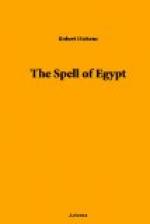Yes, there is much to make one sad at Philae. But how much of pure beauty there is left—of beauty that merely protests against any further outrage!
As there is something epic in the grandeur of the Lotus Hall at Karnak, so there is something lyrical in the soft charm of the Philae temple. Certain things or places, certain things in certain places, always suggest to my mind certain people in whose genius I take delight—who have won me, and moved me by their art. Whenever I go to Philae, the name of Shelley comes to me. I scarcely could tell why. I have no special reason to connect Shelley with Philae. But when I see that almost airy loveliness of stone, so simply elegant, so, somehow, spring-like in its pale-colored beauty, its happy, daffodil charm, with its touch of the Greek—the sensitive hand from Attica stretched out over Nubia—I always think of Shelley. I think of Shelley the youth who dived down into the pool so deep that it seemed he was lost for ever to the sun. I think of Shelley the poet, full of a lyric ecstasy, who was himself like an embodied
“Longing for something
afar
From the sphere of our
sorrow.”
Lyrical Philae is like a temple of dreams, and of all poets Shelley might have dreamed the dream and have told it to the world in a song.
For all its solidity, there are a strange lightness and grace in the temple of Philae; there is an elegance you will not find in the other temples of Egypt. But it is an elegance quite undefiled by weakness, by any sentimentality. (Even a building, like a love-lorn maid, can be sentimental.) Edward FitzGerald once defined taste as the feminine of genius. Taste prevails in Philae, a certain delicious femininity that seduces the eyes and the heart of man. Shall we call it the spirit of Isis?




